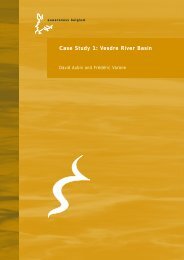Case Study 1: Matarraña River Basin - Euwareness
Case Study 1: Matarraña River Basin - Euwareness
Case Study 1: Matarraña River Basin - Euwareness
Create successful ePaper yourself
Turn your PDF publications into a flip-book with our unique Google optimized e-Paper software.
Even though the <strong>Matarraña</strong> river basin is neither too long nor too populated, the<br />
climatic, geographical, social and economic characteristics in different parts of the river<br />
basin are very different. And so the water uses and demands are. In general terms,<br />
three different areas can be distinguished along the river basin: the higher, the middle<br />
and the lower basin. The main municipalities located in the three areas are included in<br />
the following table:<br />
Higher basin<br />
Beceite<br />
Valderrobres<br />
The higher river basin<br />
Middle basin<br />
Mazaleón<br />
Maella<br />
Lower basin<br />
Fabara<br />
Nonaspe<br />
The <strong>Matarraña</strong> river is characterised by being narrow at its head and resembles a<br />
torrent or a stream. This area has lower needs of water than the rest of the river basin,<br />
both because users located at the higher river basin have traditionally had the right to<br />
use relatively more water than the rest of the river basin users, and because the<br />
extension of irrigated lands are much lower in the higher than in the middle and lower<br />
basins.<br />
In the mid sixties, peach crop —which requests high quantities of water— was timidly<br />
introduced in the higher basin, but in the seventies most crop lands were reconverted<br />
into cattle farms (and then water demands decreased). Along the nineties, rural tourism<br />
has become an important source of income in this area, but this does not seem to put<br />
too much pressure on the water issue. To sum up, the higher river basin does not have<br />
severe problems of water scarcity. However, it has been the destination of several<br />
regulation works that have been promoted by the Ebro river basin administration —the<br />
Confederación Hidrográfica del Ebro (CHE)— in order to secure water for the middle<br />
and lower river basins: the Pena water dam, that was constructed in 1930; the<br />
diversion tunnels, that were built in 1978; and the pumping project, that was installed in<br />
1998. However, given the perceived lack of efficiency of these works, as well as their<br />
cost for the higher river basin (in terms of environmental impact, expropriations,<br />
economic cost, etc), actors located at the higher basin have increasingly rejected<br />
projects promoted by the CHE.<br />
6



